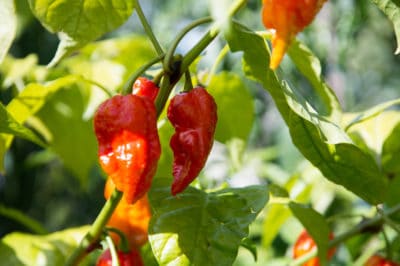Precaution
Always wear gloves when working with peppers this hot. The Scoville rating for a ghost pepper is 1,001,304 units. For perspective:
- Habanero – 250,000 Scoville Unites
- Jalapeno – 6000 Scolville Units
- Anaheim – 1000 Scolville Units
While capsicum has not been shown to cause any actual tissue damage, it is extremely painful. Pets and children should be kept well away from growing ghost peppers. These fruits are so spicy that you may not even want to process them inside.
If you are chopping them, do it outside with fresh air. Wear gloves and goggles and avoid touching your eyes, nose, mouth, or skin after handling ghost peppers.
How To Plant
Plant ghost peppers 8-12 weeks before the last frost in your region. In USDA zones 11 and above peppers can be treated as perennial plants. In these tropical regions plant seed any time of the year.
Use a high-quality well-draining potting soil for starting pepper seeds. Seed blocks or four-inch garden pots work equally well. Keep the soil damp but do not over-water especially when seedlings are young and prone to damping off.
Seedling Care
Upon sprouting move seedlings under fluorescent lights or into a sunny window. Extra light ensures that the plant will not elongate out and require more staking or caging.
Seedlings can be transplanted outside two weeks after the last frost date. Only put them out if soil temperatures are holding above 65°F (18°C). They must be acclimated when moving from an indoor space to an outdoor space.
Acclimate plants by bringing them out into some dappled light for one half-hour the first day. Gradually increase the time they spend outside over the course of one to two weeks. Expose them to increasing amounts of wind, direct sunlight, and temperature shifts between day and night time.
They are ready to transplant when they can be outdoors for a full 24-hour day and not show any signs of stress.
How To Feed And Water
Stick to a watering schedule that delivers consistent moisture. Do not overwater and allow the planting bed to become muddy. Avoid spraying the foliage and try to water down by the base of the plant as much as possible.
Mix one to three inches of compost into the outdoor planting bed. This will ensure that plants get a boost of nutrients while adjusting to their new home. Feed with liquid organic fertilizer when plants start to set fruit.
Harvest
Harvest ghost peppers when the fruit is firm and brightly colored. Always wear safety gear.
